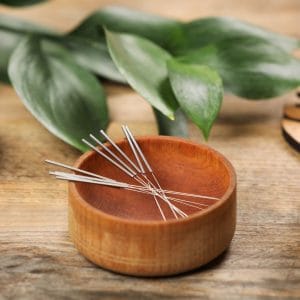
By Miss Kayla Durant, Registered Physiotherapist
Understanding the Differences and Benefits
Acupuncture and Dry Needling are both techniques that involve the insertion of thin needles into the skin to alleviate pain and treat various conditions. Although, the two techniques share some similarities, they have different origins, philosophies and applications.
Origins and Philosophies
Acupuncture
Acupuncture is a key component of Traditional Chinese Medicine (TCM), an ancient healthcare system focused on balancing the body’s vital energy, or qi (pronounced chi). TCM believes that qi flows through energy channels in the body called meridians, and when blocked, it disrupts the balance between yin and yang, leading to illness. Acupuncture involves stimulating acupoints, which are specific points along these meridians to restore the proper flow of qi, promoting overall health and well-being. It is often used to treat a wide range of conditions inclusive of chronic pain, digestive disorders, stress and neurological pathologies.
Dry Needling
Dry needling, however, is a relatively modern technique based on Western medicine. It emerged in the 20th century and is primarily used by Physical Therapists, Chiropractors and other healthcare providers trained in treating musculoskeletal related pathologies. This technique primarily focuses on relieving muscular pain and dysfunction. It targets myofascial trigger points, which are hyperirritable and painful “knots” within a taut band of skeletal muscle. These are often associated with pain and restricted movement. Unlike acupuncture, dry needling does not rely on traditional meridians or qi. Rather, it uses anatomy and neurophysiology to release muscle tension, improve blood flow and promote normal function hence decreasing pain and restoring movement.
Techniques and Applications
Acupuncture
Acupuncture involves inserting thin, sterile needles into acupoints. The placement of the needle i.e. its depth, angle, and location depend on the condition being treated. To achieve an enhanced therapeutic effect, the needles may be manually manipulated, stimulated with mild electrical currents which is known as electroacupuncture, or they can be heated which is known as moxibustion.
Acupuncture is used to treat:
- Chronic pain conditions such as arthritis, migraines and fibromyalgia
- Anxiety and depression
- Digestive disorders such as irritable bowel syndrome, nausea and gastritis
- Insomnia and fatigue
- Hormonal imbalances
- Respiratory conditions such as asthma and allergies
Dry Needling
Dry needling is focused on relieving myofascial trigger points, often known as “knots” or “hard nodules” in the muscle. These hyperirritable spots can cause pain and dysfunction. A tiny needle is inserted directly into the myofascial trigger point, which typically results in a twitch response. This response signifies the release of the muscle tension, which reduces discomfort and enhances movement.
Dry needling is particularly beneficial for:
- Sports injuries and muscular strains
- Chronic musculoskeletal pain
- Tendinitis and joint dysfunctions
- Post-surgical rehabilitation
- Improving mobility and flexibility
Differences
- Philosophical Approach
-
- Acupuncture is based on TCM principles and the concept of qi and meridians.
- Dry needling is rooted in Western medicine and focuses on muscular anatomy and physiology.
- Treatment Goals
- Acupuncture aims to balance qi and treat a variety of systemic conditions.
- Dry needling is primarily used for pain relief and musculoskeletal rehabilitation.
- Needle Placement
- Acupuncture uses acupoints (predefined meridian points).
- Dry needling targets myofascial trigger points.
Contraindications
Some contraindications include:
- Critically ill patients
- Uncontrolled conditions such as epilepsy and diabetes
- Active infection such as cellulitis
- Lymphedema
- Auricular acupuncture with patients who have heart valve defects
- Allergy to zinc or nickel
Effectiveness and Safety
Effectiveness
Both acupuncture and dry needling have been shown to be effective for pain management, although their mechanisms differ.
- Studies suggest that acupuncture can stimulate the nervous system, release endorphins and reduce inflammation which contributes to long-term pain relief.
- Dry needling helps deactivate trigger points, reduce muscle tightness, and improve range of motion, making it highly effective for musculoskeletal issues.
Safety Considerations
Both techniques are generally safe when performed by trained professionals. However, some risks for acupuncture include bruising, minor bleeding, dizziness, or infection if performed improperly and for dry needling are temporary soreness, bruising, or, in rare cases, nerve irritation.
Conclusion
Acupuncture is a holistic strategy based on the principles of TCM whilst dry needling is a modern technique that targets musculoskeletal discomfort. Both therapies have proven to be beneficial and can be useful tools for alleviating pain and improving overall wellness.


Leave a Comment